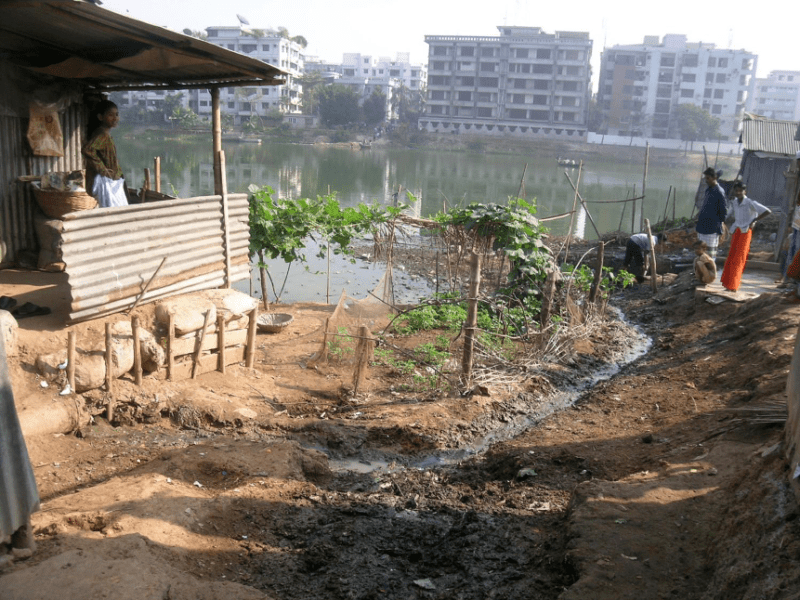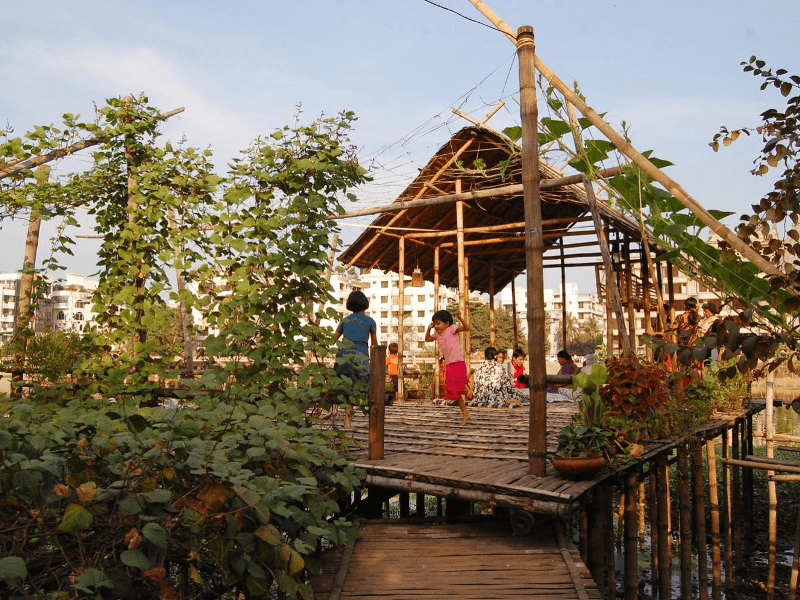
The International Day of Play (IDOP), held annually on June 11th, is a unifying global moment to celebrate the power of play for all children everywhere. IDOP draws attention to Article 31 of the UN Convention on the Rights of the Child, which recognizes children’s right to age-appropriate play, recreation, rest and leisure. It can act as a catalyst for action to promote this right, particularly in cities, where safe, stimulating places for play are fast disappearing.
Play Is Fundamental for All Children
Play is not frivolous. Through play, children discover and make sense of the world, bond with family, peers and nature, learn to appreciate art, culture and traditions, and build skills for life. Play, in short, is fundamental for the development of healthy, happy and caring individuals.
Children generally find a way to play even in the least accommodating situations. But ideally, play opportunities should be close to home, diverse, inviting, safe yet challenging, and allow for contact with nature and the wider spatial environment.
But these opportunities and spaces for everyday play are vanishing in urban areas due to expanding built-up areas caused by the pressures of rapid urbanization. In many global South cities, lanes and streets outside homes, where caregivers can watch children as they play, are taken over by vehicles, garbage or open drains. Green spaces are disappearing and are almost non-existent in the poorest neighborhoods where they are most needed. Further, play provision in cities rarely goes beyond static playgrounds with fixed equipment.
So, how can we transform our cities to nurture children’s play, especially in the heart of low-income neighborhoods?
Understand Where and How Children Play
This is crucial as urban practitioners continue to equate play provision for children with creating formal parks and playgrounds. However, observing children’s free play, particularly in low-income neighborhoods, makes it clear that liminal spaces (informal, leftover spaces), typically not designed for play, with abundant loose parts such as sand, water, mud, sticks, stones and other materials, can be vital for fulfilling children’s right to play.Liminal spaces include small open spaces around buildings, vacant lots, narrow streets and alleys, staircases, terraces and doorsteps.
As part of a research-into-action project, Play@Khirkee, I observed children play in Khirkee, New Delhi. Because of its special status as an urban village, Khirkee’s narrow lanes and car-free open spaces are, to a large extent, protected and preserved.
Observations of children’s play showed that:
- Boys, girls, younger and older children played every day outdoors. They mainly played in liminal spaces using loose parts like leaves, twigs, stones, sand and treasures retrieved from construction debris, making up games and rules.
- Khirkee did not have a single equipped park or playground. But children idealised parks and playgrounds as preferred places for play despite spending just a fraction of their outdoor playtime in them. However, in practice, children preferred and played more creatively in a park that lacked maintenance and, by extension, rules and restrictions for play, as compared to a well-maintained and rule-dominated larger park.
- Play flowed through an interconnected system of large green spaces, pedestrian streets, squares and tiny parks. Children took full advantage of this spatial arrangement; boys would start out playing sports in large open spaces after school and by sunset would trickle into the streets where girls and younger children were already playing more traditional games. Both boys and girls engaged in spontaneous games of hide-and-seek using the staircases and terraces of nearby flats before finally entering the tiny park that served as their outdoor living room.

Despite the joy and freedom associated with play in Khirkee, some physical and social barriers to play also became apparent through neighborhood observation. These included:
- Prohibitive signage in more formal parks restricts play on the grass or with any outside toys or equipment. Every evening, an office bearer of the Residents Welfare Association came around with a thick stick to chase away the children and ensure that the manicured lawns and flower beds were protected.
- Adults are taking over fenced parks for growing plants and other activities, restricting children’s play.
- Children were afraid to play in places that were dirty and dark or where adults were drinking and gambling.
- Older women prevent entry to local parks for children from lower castes.
The study highlighted that children are creative and resourceful in carving out their play spaces and opportunities. More than designing and building parks and playgrounds for play, identifying, protecting and preserving spaces claimed by children for play is vital for enabling play in neighborhoods. For that to happen, there is a need to engage with adults in positions of authority and community-based organizations to advocate for and enable all children’s right to play.
Examples of Co-Creating Neighborhood Play Environments
1. A mobile, pop-up play solution developed in Khirkee, New Delhi
Khoj, the local arts NGO that supported the Play@Khirkee study, asked me to design an inclusive play space for children. Having observed how children play, I was convinced that creating another park would not further play opportunities for children.
Instead, along with my collaborator Subrata Ghosh, I decided to protect, preserve and enhance play in existing play spaces by involving children and the community in codesigning a pop-up play system called Play-on-Wheels. The system uses pushcarts containing various play affordances (in addition to storage space for toys and books) that can be wheeled through narrow lanes. This system allowed local organizations to set up temporary play environments using loose parts in any street or open space at any time.

Play-on-Wheels was first piloted in a low-income neighborhood in the city of Kolkata by an NGO that works on children’s rights, and not in Khirkee, as the village lacked community-based organizations working with children.
However, Play-on-Wheels was challenging to maintain as a long-term neighborhood resource. Securing a safe storage space for the pushcarts and extending continued support to local NGOs to manage and maintain the intervention was difficult. Instead, Play-on-Wheels is operational today within the controlled environment of a children’s home for HIV-positive children in Kolkata that has ample open spaces but little opportunities for free play.
2. Dry canal transformed into safe and active play zone in Fresnillo, Mexico
In the city of Fresnillo, Mexico, architects Alin W. Wallach and Rozana Montiel leveraged Mexico’s Social Housing Renewal and Revitalization Program (PROCHURA), to transform a half-kilometer-long dry drainage canal, that runs through the heart of a 40-year-old social housing development, into a safe and active play zone.
The PROCURHA program engaged architectural firms to partner with local governments and communities to develop and produce locally relevant and low-cost innovative solutions for public and communal spaces in largely run-down neighborhoods.
The architects observed the spontaneous ways children played in the paved drainage canal – such as sliding down the sides on garbage can lids – and decided to retain and enhance the canal as a play space. New sliding and seating spaces, a universally accessible bridge, greenery and additional play affordances were added to uplift the space. Community groups activated the space with festivals and group classes to enhance social life. The innovative design of the play and recreational environment with durable, fixed materials makes it easy to maintain and transforms an urban liminal space.
3. Play in an informal settlement in Dhaka, Bangladesh
Landscape and community architect Khondaker Hasibul Kabir engaged with informal settlement residents to co-create housing projects and public spaces in Bangladesh. One of his early interventions is in Korail, a large slum settlement on the banks of Banani lake in Dhaka. Kabir decided to live in Korail to understand the local community’s needs better. In his conversations with local children, he discovered what they wanted most was a play space they could claim and call their own.

This led to the co-creation of a raised bamboo platform over the lake abutting their settlement. Children were the main protagonists, designers and negotiators. They reached out to relatives, parents and grandparents – anyone who would listen to them in the community – to help construct their bamboo platform.
The play space called Ashar Macha (in English, “Platform of Hope”) was built by the community. It became a central community node valued by children and women, particularly for play, socialization and rest. Children and the community took responsibility for managing and maintaining Ashar Macha. The platform’s success spurred further changes in the community, such as transforming unused spaces into small-scale gardens and farms.

4. Play at street intersections in Maputo, Mozambique
UN-Habitat and partners in Maputo, Mozambique, involved children in codesign processes to improve the quality of public spaces in the city. An intervention site was identified in a neighborhood that experienced high rates of crime and violence and lacked adequate public services.
Exploratory walks with children indicated that pathways and roads were their main spaces for play. The intervention site was a liminal space in the heart of an intersection of three unpaved roads. The large street intersection was codesigned with children to include play, rest, leisure and socialization spaces.
The intervention’s sustainability is embedded in its participatory approach. Local communities, including children and local civil society associations that co-created the spaces, play an active role in maintaining and managing them.

—
The four examples from India, Mexico, Bangladesh and Mozambique show that despite the many challenges of rapid urbanization and growing inequality, children claim diverse places in the public realm for play outside formal parks and playgrounds. The examples make a strong case for respecting children’s rights to play and engaging them in reconceptualizing public spaces to protect, preserve and promote play in cities. Liminal spaces in neighborhoods and cities should be viewed as vibrant children’s territories where some of the richest play experiences are nurtured and where promoting children’s play furthers children’s right to the city.
Dr. Sudeshna Chatterjee is Program Director of Sustainable Cities and Transport at WRI India’s Ross Center for Sustainable Cities.






